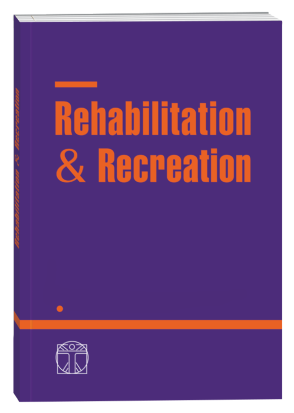A PRACTICAL MODEL FOR USING THE CANADIAN OCCUPATIONAL PERFORMANCE MEASURE (COPM) IN THE REHABILITATION OF MILITARY PERSONNEL AND CIVILIANS IN ACUTE AND POST-ACUTE REHABILITATION IN UKRAINE
DOI:
https://doi.org/10.32782/2522-1795.2025.19.2.9Keywords:
occupational therapy, rehabilitation, outcome measures, grounded theory, military personnel, individual rehabilitation plan, individual program of rehabilitation, effective communicationAbstract
Objective. The aim of the study was to develop a scientifically based model for the effective use of the Canadian Occupational Performance Measure (COPM) in the acute and post-acute rehabilitation phase of military personnel and civilians in Ukraine. Material and methods. To develop a model based on constructivist grounded theory, 20 individual interviews with occupational therapists from six regions of Ukraine were conducted and analyzed. Multilevel qualitative analysis was conducted by two independent researchers using the methodology of immersive interview reading, constant comparative analysis, sequential levels of abstraction to develop codes, concepts and categories during open, axial and selective coding resulting in a graphic model. To verify and supplement the data, we held a focus group with interview participants and conducted additional four interviews with occupational therapy clients/patients. Results. As a result of data analysis, a model of effective use of the COPM in Ukraine with military personnel and civilians during acute and post-acute rehabilitation was developed. The process of using the COPM is symbolically depicted as a mechanism of interaction between an occupational therapist and an occupational therapy client/patient that results in the set goals for an individual rehabilitation program. The model is based on factors of the therapist and the occupational therapy client/patient that have the potential to promote effective therapeutic interaction or be barriers in the process of using the COPM. Factors that concern the occupational therapist include: occupational focus, client-centeredness, individualization of the occupational therapy process, training in the use of the COPM, explaining the purpose of the COPM to the client, effective interviewing and communication skills, appropriate use of examples, trauma-informed care, and client advocacy in involving the family in the rehabilitation process. The client/patient factors necessary for the effective use of the COPM are the following: a positive attitude towards the client- centeredness and occupational focus of occupational therapy, the presence of a specific occupational need, a sufficient level of cognition and speech, understanding of occupational therapy scope of practice, motivation, an unbiased attitude towards the occupational therapist, adequate insight into one’s own condition and occupational freedom. The study participants identified a significant impact of the COPM on the professional development of therapists, in particular the development of an occupational paradigm and improving the quality of service provision due to the increased occupational focus of occupational therapy. Occupational therapists also appreciate the informative nature of the COPM, its ability to demonstrate progress of the client/patient, the expanded professional impact and environment of service provision, providing occupational therapy with a potentially leading role in the multidisciplinary rehabilitation team and professional pride. The discussion highlighted the unique factors of the Ukrainian context during a full-scale war, as well as factors that are supported by data from foreign literature. Conclusions. As a result of qualitative research, a model of effective use of the COPM in the acute and post-acute stage of rehabilitation of the military personnel and civilians in Ukraine was developed and scientifically substantiated. The model will be useful in the process of formal education of occupational therapists and continuous professional development of practicing therapists.
References
1. Baumann, M.L., Brown, A.N., Quick, C.D., Breuer, S.T., & Smith-Forbes, E.V. (2018). Translating Occupational Therapy’s Current Role Within U.S. Army Combat and Operational Stress Control Operations. Occupational Therapy in Mental Health, 34(3), 258–271. https://doi.org/10.1080/0164212X.2018.1425952
2. Caire, J.-M., Maurel-Techene, S., Letellier, T., Heiske, M., Warren, S., Schabaille, A., & Destruhaut, F. (2022). Canadian Occupational Performance Measure: Benefits and Limitations Highlighted Using the Delphi Method and Principal Component Analysis. Occupational Therapy International, 2022, 9963030. https://doi.org/10.1155/2022/9963030
3. Charmaz, K., & Thornberg, R. (2021). The pursuit of quality in grounded theory. Qualitative Research in Psychology, 18(3), 305–327. https://doi.org/10.1080/14780887.2020.1780357
4. Creswell, J.W. & Creswell, J.D. (2018). Research design: Qualitative, quantitative, and mixed methods approaches (Fifth edition). SAGE.
5. Farber, R.S. (2000). Mothers With Disabilities: In Their Own Voice. The American Journal of Occupational Therapy, 54(3), 260–268. https://doi.org/10.5014/ajot.54.3.260
6. Farias, A.A.R., Souza, A.M. de, & Corrêa, V.A. C. (2024). Occupations, freedom, and values: A case study in a Coronary Intensive Care Unit. Cadernos Brasileiros de Terapia Ocupacional, 32, e3679. https://doi.org/10.1590/2526-8910.ctoao282836792
7. Hammersley, M., & Atkinson, P. (2019). Ethnography: Principles in practice (Fourth edition). Routledge.
8. Kerr, N.C., Ashby, S., Gerardi, S.M., & Lane, S.J. (2020). Occupational therapy for military personnel and military veterans experiencing post‐traumatic stress disorder: A scoping review. Australian Occupational Therapy Journal, 67(5), 479–497. https://doi.org/10.1111/1440-1630.12684
9. Larsen, A.E., & Law, M. (2025). Canadian Occupational Performance Measure the state of the art – a review. Scandinavian Journal of Occupational Therapy, 32(1), 2473045. https://doi.org/10.1080/11038128.2025.2473045
10. Lazarieva, O.B., Mangusheva O.O., Klavina, A. & Enemark Larsen, A. (2025). Aktualnist vykorystannia Kanadskoho instrumenta otsinky vykonannia zaniat (COPM) dlya klientoorientovanoi ta zaniattievospriamovanoi erhoterapevtychnoi praktyky v Ukraini. [The impact of the Canadian occupational performance measure (COPM) on client-centered and occupationfocused occupational therapy practice in Ukraine]. Sportyvna medytsyna, fizychna terapia ta erhoterapiia, 1, 210–217. https://doi.org/10.32782/spmed.2025.1.30 [in Ukrainian]
11. Lauritzson, A., Eckerdal, D., & Atroshi, I. (2023). Responsiveness of the patient-specific Canadian occupational performance measure and a fixed-items activity limitations measure in patients with dupuytren disease. Journal of Patient-Reported Outcomes, 7(1), 38. https://doi.org/10.1186/s41687-023-00579-7
12. Loubani, K., Polo, K.M., Baxter, M.F., & Rand, D. (2024). Identifying Facilitators of and Barriers to Referrals to Occupational Therapy Services by Israeli Cancer Health Care Professionals: A Qualitative Study. The American Journal of Occupational Therapy, 78(1), 7801205050. https://doi.org/10.5014/ajot.2024.050414
13. Mangusheva, O.O., Lazarieva, O.B., & Enemark Larsen, A. (2024). Exploring the use of the Canadian Occupational Performance Measure (COPM) in Ukraine: Determining the need. Rehabilitation and Recreation, 3, 32–40. https://doi.org/10.32782/2522-1795.2024.18.3.3
14. Mangusheva, O.O., Lazarieva, O.B., & Enemark Larsen, A. (2025). Translation, cross-cultural adaptation and content validation of the Canadian Occupational Performance Measure (COPM) in the Ukrainian language. Medicni Perspektivi, 30(1), 135–149. https://doi.org/10.26641/2307-0404.2025.1.325375
15. Murthi, K., & Hammell, K.W. (2021). ‘Choice’ in occupational therapy theory: A critique from the situation of patriarchy in India. Scandinavian Journal of Occupational Therapy, 28(1), 1–12. https://doi.org/10.1080/11038128.2020.1769182
16. Nakken, N., Janssen, D.J.A., van den Bogaart, E.H.A., van Vliet, M., de Vries, G.J., Bootsma, G.P., Gronenschild, M.H.M., Delbressine, J.M.L., Muris, J.W.M., Wouters, E.F.M., & Spruit, M.A. (2017). Patient versus proxy‐reported problematic activities of daily life in patients with COPD. Respirology, 22(2), 307–314. https://doi.org/10.1111/resp.12915
17. Ohno, K., Tomori, K., Sawada, T., Seike, Y., Yaguchi, A., & Kobayashi, R. (2021). Measurement Properties of the Canadian Occupational Performance Measure: A Systematic Review. The American Journal of Occupational Therapy, 75(6), 7506205100. https://doi.org/10.5014/ajot.2021.041699
18. Plach, H.L., & Sells, C.H. (2013). Occupational Performance Needs of Young Veterans. The American Journal of Occupational Therapy, 67(1), 73–81. https://doi.org/10.5014/ajot.2013.003871
19. Pro zatverdzhennia Pereliku rekomendovanykh instrumentiv otsiniuvannia funktsionuvannia, obmezhen zhyttiediialnosti ta zdorovia osoby, Nakaz MOZ Ukrainy. № 1946, 20 Nov. 2024 (Ukraine). [in Ukrainian]
20. Ramalho, R., Adams, P., Huggard, P., & Hoare, K. (2015). Literature Review and Constructivist Grounded Theory Methodology. Forum Qualitative Sozialforschung / Forum: Qualitative Social Research, Vol 16, No 3 (2015). https://doi.org/10.17169/FQS-16.3.2313
21. Sawada, T., Tomori, K., Ohno, K., Takahashi, K., Saito, Y., & Levack, W. (2022). Information bias in the Canadian occupational performance measure: A qualitative study. British Journal of Occupational Therapy, 85(9), 722–732. https://doi.org/10.1177/03080226221079234
22. Skär, M.T., Lisa. (2000). How I Play: Roles and Relations in the Play Situations of Children with Restricted Mobility. Scandinavian Journal of Occupational Therapy, 7(4), 174–182. https://doi.org/10.1080/110381200300008715
23. Stanley, M., & Cheek, J. (2003). Grounded Theory: Exploiting the Potential for Occupational Therapy. British Journal of Occupational Therapy, 66(4), 143–150. https://doi.org/10.1177/030802260306600403
24. Sweeney, G., Webley, P., & Treacher, A. (2001). Supervision in Occupational Therapy, Part 2: The Supervisee’s Dilemma. British Journal of Occupational Therapy, 64(8), 380–386. https://doi.org/10.1177/030802260106400802
25. Walder, K., & Molineux, M. (2017). Re-establishing an occupational identity after stroke – a theoretical model based on survivor experience. British Journal of Occupational Therapy, 80(10), 620–630. https://doi.org/10.1177/0308022617722711
26. Yang, S.-Y., Lin, C.-Y., Lee, Y.-C., & Chang, J.-H. (2017). The Canadian occupational performance measure for patients with stroke: A systematic review. Journal of Physical Therapy Science, 29(3), 548–555. https://doi.org/10.1589/jpts.29.548
Downloads
Published
How to Cite
Issue
Section
License

This work is licensed under a Creative Commons Attribution-NonCommercial-NoDerivatives 4.0 International License.





